If you would like to get email notices when a new list appears, send your email address. No other details are necessary.

Prices are in Australian dollars






Shop architecture. 商店建築及店頭計画図案 [Shoten Kenchiku Oyobi Tento Keikaku Zuan]. Tokyo, Kenchikushoin 1924 (Taisho 13). Oblong folio, 26x39cm, publisher's decorated cloth (a bit marked and touch worn); [10]pp, 50 b/w plates, [4]pp. on hold
Modern and moderne shop buildings and store fronts; essential if you want to rebuild Tokyo after the earthquake and before the fire bombing. This is, of course, part of the post earthquake reconstruction effort: the results of a competition held by the equivalent of the Tokyo chamber of commerce. The plates, elevations and floor plans, are reproduced from measured drawings and look ready to build but I wonder about one (by Shibahara Niro) which seems to be taken straight from Bruno Taut's crystal alpine architecture. The requirements: frontage, height etc, are spelt out in the introduction and I presume fit an average commercial lot. At the end are designs for shop fronts.
Worldcat finds no copies outside Japan; neither have I.
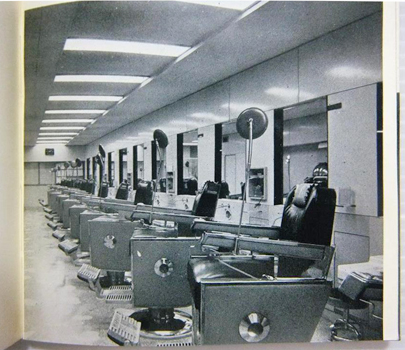
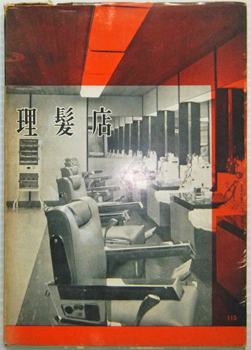
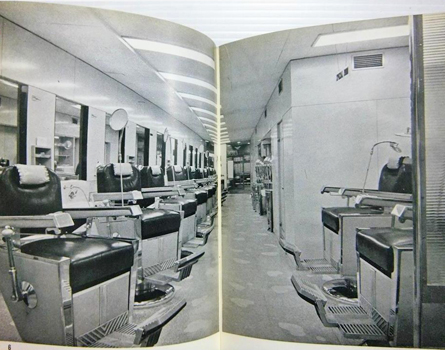
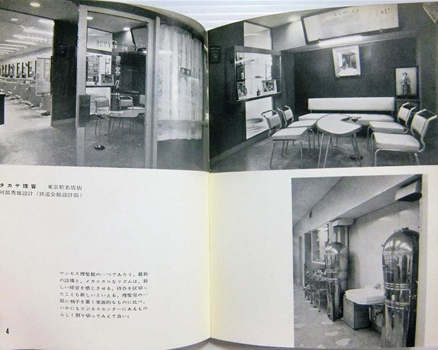
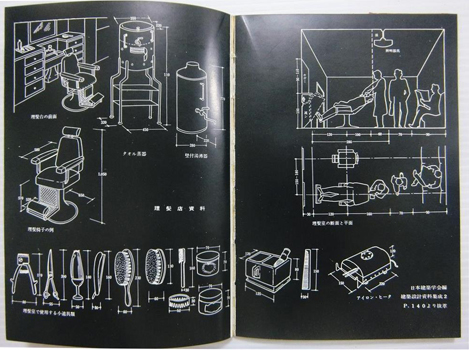

Barber shops. 理髪店 [Rihatsuten]. Tokyo, Shokukusha 1956 (Showa 31). 19x13cm publisher's wrapper and dustwrapper; 79pp illustrated throughout with photos and a few drawings. Au$275
If you've also been unhappy about the lack of information on mid-century Japanese barber shops and hairdressers you too will be pleased to find this. This is volume 115 of the epic series of architectural photographic monographs - Kenchiku Shashin Bunko - put out from the early fifties to about 1970. The more obvious subjects - kitchens, living rooms, fences, restaurants and cafes - were returned to several times over the years but barbers only reappeared right at the end as an adjunct to a revisit to beauty salons.
Some titles are easier to find than others but this is not one of them, especially in good shape in dustwrapper.

Greater Japan Islamic Society. 我が南洋貿易と回教徒 [Waga Nan'yo Boeki to Kaikyoto]. Tokyo, 1939 (Showa 14). 22x15cm publisher's printed wrapper; [2],58pp. Cover spotted, staple stains; pretty good. sold
Here's a footnote in world history new to me: Japan and Islam. The Islamic Society was not, I'm sorry to say, a group of Japanese Muslims but more a bureau set up in 1938 to foster relations with the Islamic world, educate the Japanese and formulate policy for a significant population within the growing Japanese empire. The title of this booklet more or less translates as South Seas Trade and Muslims. It is labelled secret and was not for sale.
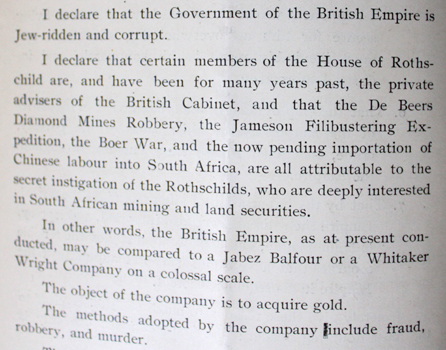
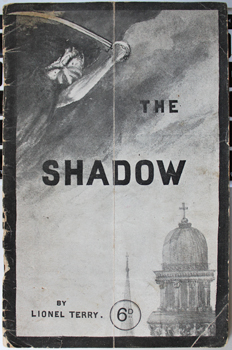
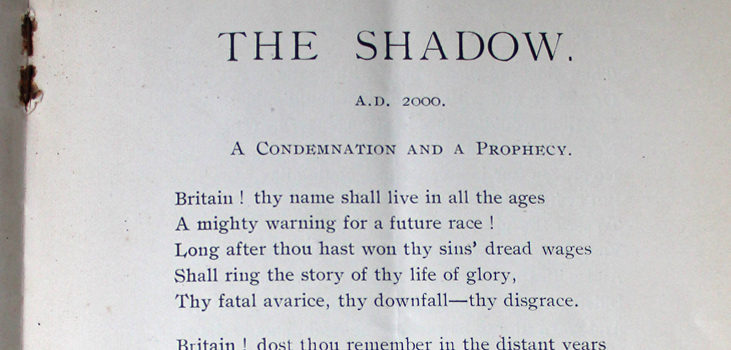

TERRY, Lionel. The Shadow. Auckland, printed by Wilson & Berton 1904. Octavo publisher's illustrated wrapper (all but detached, used, an old vertical fold); 30,[2]pp. A bit of a mangy copy perhaps but when you're the only tiger still in the jungle you deserve respect. Au$400
This is pretty rare; it's taken me decades to find a copy since I underestimated the first one I saw in a New Zealand auction. I'm a bit sorry I have. This is a mad and nasty bit of yellow peril invective by a mad and nasty man. The story is well known enough: Terry published this and followed it up by walking pretty much the length of New Zealand's north island to Wellington where soon after, dissatisfied with the progress of his anti-Asian campaign, he shot an old, crippled Chinese man in the back of the head. Terry surrendered to police, handing them copies of this. Sales jumped and Terry resisted attempts to have him declared insane.
Like all canny fear mongers Terry identifies the Asian peril as merely the result of a darker plot: the Shadow controlling it all is of course the Jew. The main part, the poem The Shadow, is written looking back from the year 2000. Terry had plenty of friends and sympathisers at the time but perhaps the most dispiriting part of this is coming across a recent long essay on a white suprematist website defending Terry and extolling his message.
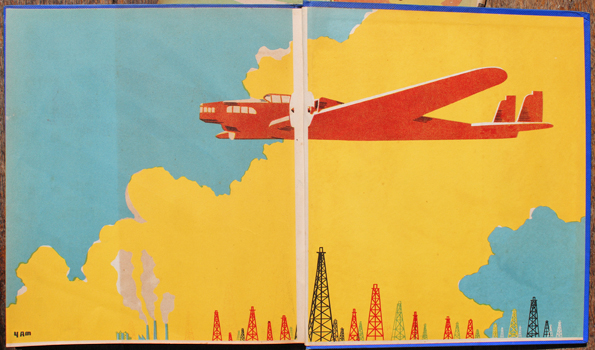
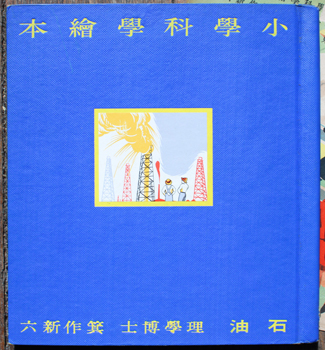
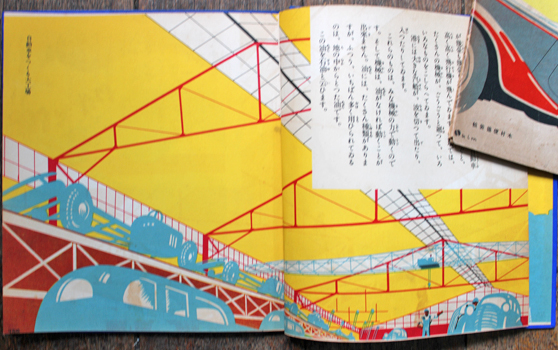
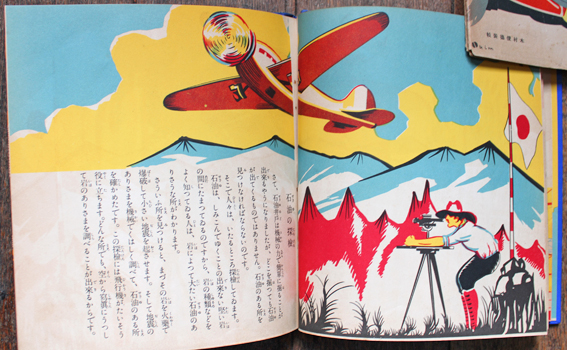
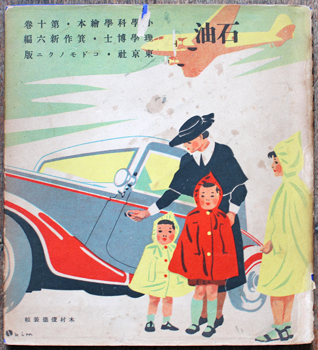

Yamashita Ken'ichi (illustrator). 小学科学絵本 : 石油 [Shogaku Kagaku Ehon : Sekiyu] . Tokyo, Mitsukoshi 1937 (Showa 12). 215x195mm, publisher's boards with mounted illustration, dustwrapper (this used: browned and a bit chipped); colour and b/w illustrations by Yamashita throughout. Some browning here and there. Au$150
This is volume 10 of the 12 volumes series Shogaku Kagaku Ehon - elementary science - devoted to oil. This is a quite exciting and vivid series hidden under dreary dustwrappers so it is natural to discard the dustwrappers immediately. They seemed inexplicable to me until I realised that many of these artists were in disgrace with officials and neither high modernism nor the fanciful were suitable for anyone let alone an impressionable child. The dustwrappers are the book equivalent of thick rimmed glasses and a false moustache. Proof that communists and such troublemaking artistic riff-raff can't be trusted.
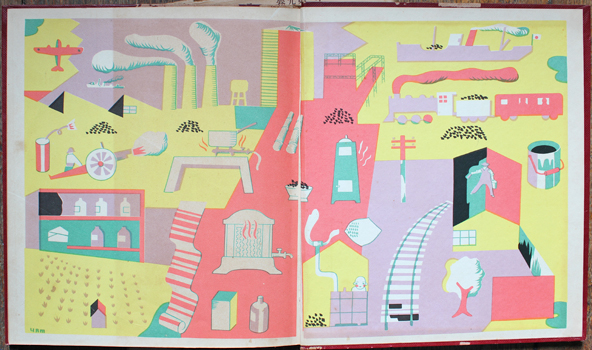
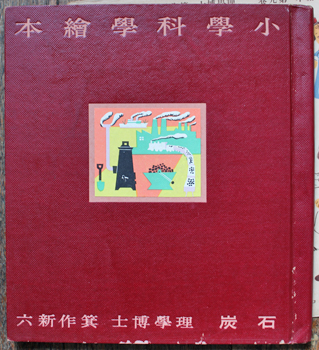
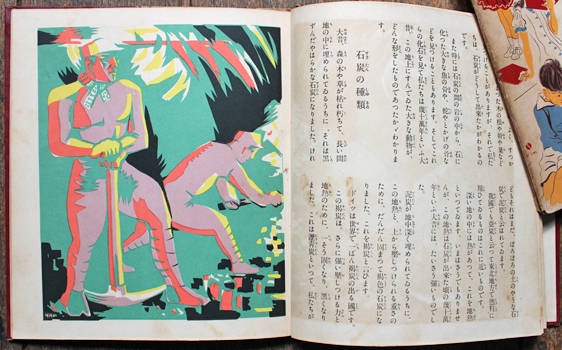
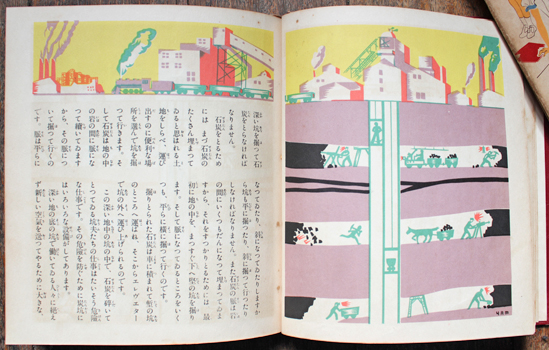
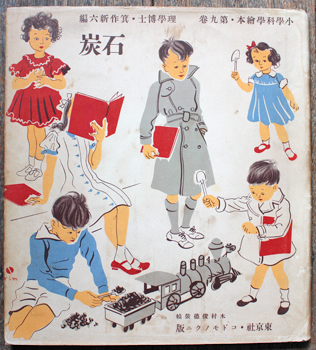

Yamashita Ken'ichi (illustrator). 小学科学絵本 : 石炭 [Shogaku Kagaku Ehon : Sekitan] . Tokyo, Mitsukoshi 1937 (Showa 12). 215x195mm, publisher's boards with mounted illustration, dustwrapper (this used: browned and a bit frayed); colour and b/w illustrations by Yamashita throughout. Some browning here and there. Au$125
This is volume 9 - devoted to coal.

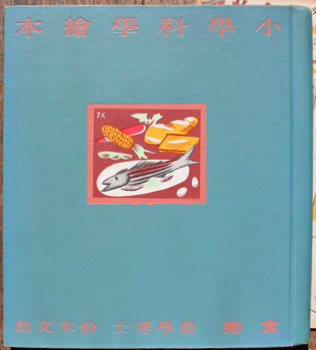
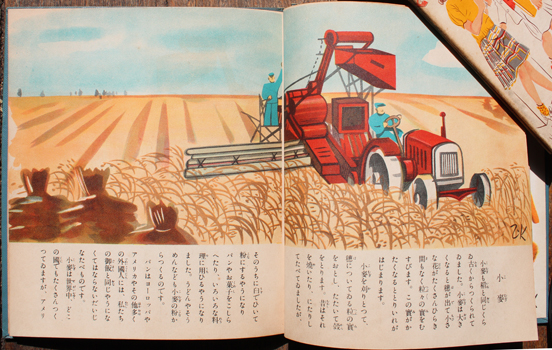
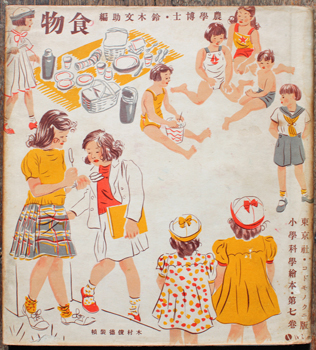

Kurita Jiro. (illustrator). 小学科学絵本 : 食物 [Shogaku Kagaku Ehon : Shokumotsu] . Tokyo, Mitsukoshi 1937 (Showa 12). 215x195mm, publisher's boards with mounted illustration, dustwrapper (this a bit browned and smudged); colour and b/w illustrations throughout by Kurita. Some browning. Au$80
This is volume 7 - devoted to food.
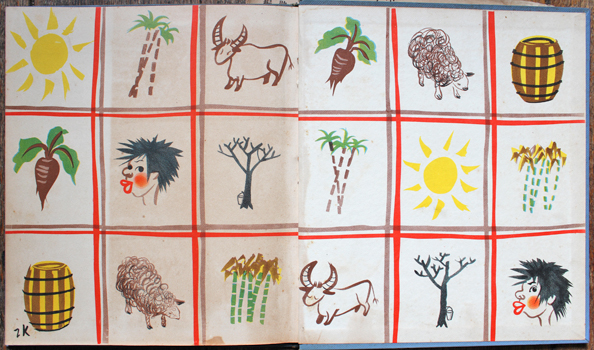
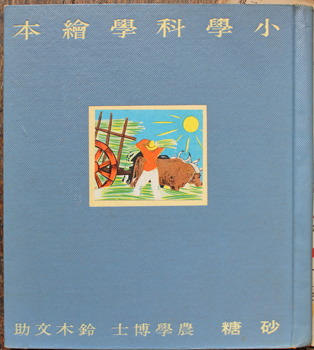
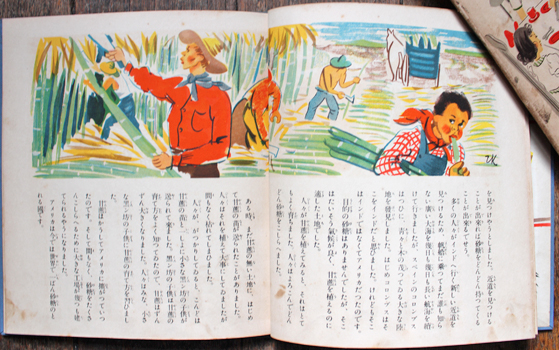
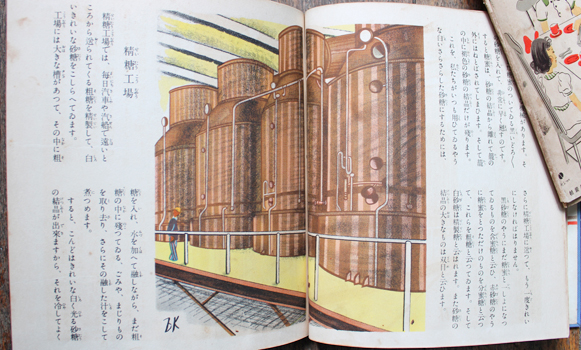
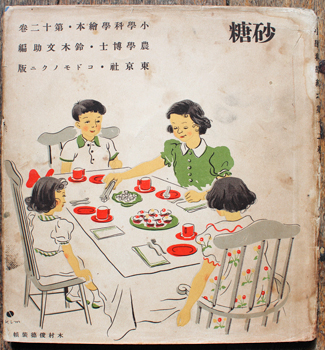

Kurita Jiro (illustrator). 小学科学絵本 : 砂糖 [Shogaku Kagaku Ehon : Sato]. Tokyo, Mitsukoshi 1937 (Showa 12). 215x195mm, publisher's boards with mounted illustration, dustwrapper (this worn and browned but all there); colour and b/w illustrations throughout by Kurita. Some browning of offsetting. Au$80
This is volume 12 - devoted to sugar.
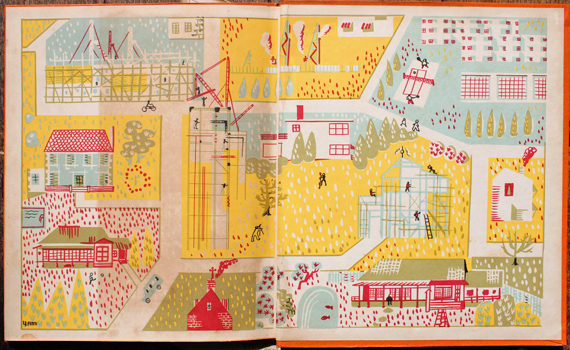
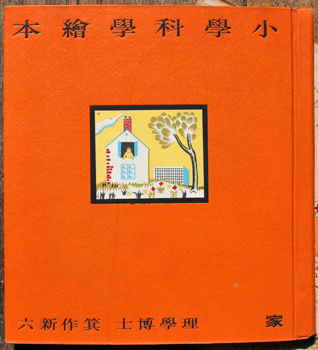
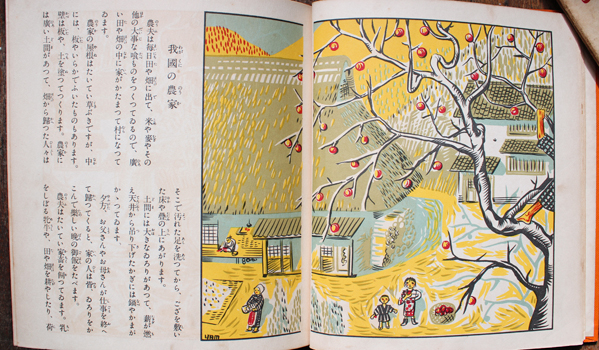
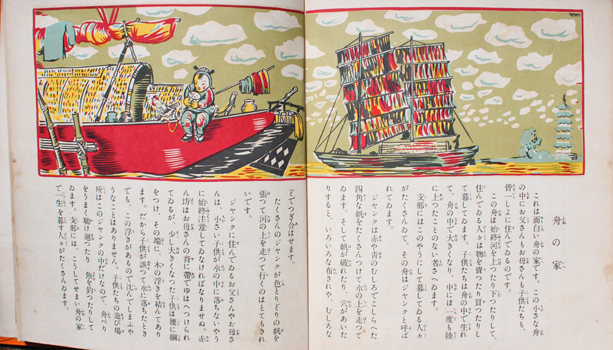
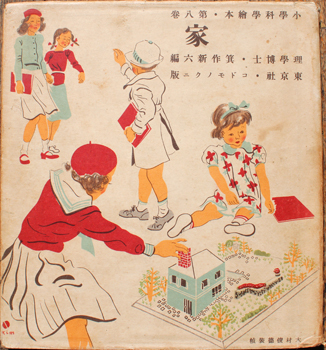

Yamashita Ken'ichi (illustrator). 小学科学絵本 : 家 [Shogaku Kagaku Ehon : Ie] . Tokyo, Mitsukoshi 1937 (Showa 12). 215x195mm, publisher's boards with mounted illustration, dustwrapper (this used: smudged and a bit frayed); colour and b/w illustrations by Yamashita throughout. Some browning here and there. Au$100
This is volume 8 - devoted to housing.




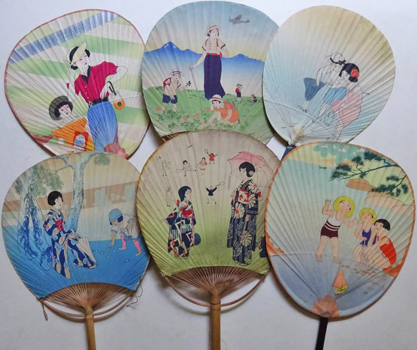

Advertising fan sample books. 優美団扇見本帖 + 優美団扇新画帳 [Yubi Uchiwa Mihon Jo] + [Yubi Uchiwa Shin Gacho] + six actual advertising uchiwa - fans. n.p. c1930.
The first: 23x25cm publisher's colour illustrated wrappers, ribbon tied; title leaf, 81 leaves (four of these form two designs with one of each being a layer with cutouts over the other). Covers ragged, a few leaves with closed tears near the beginning; the album has been damp at some time and colours drifted to nearby leaves in places but all acceptable enough.
The second: 25x25cm colour printed wrapper; ribbon tied; 42 leaves. Used and well thumbed but solid and decent enough.
The fans each about 40cm top to tail.
Au$2100
Two (but not a pair) of these rare sample books of elegant (yubi translates as elegant) uchiwa - non folding fans - used for advertising; messages were on the back. Now, pattern books of properly elegant fan designs have a long history and are a dime, well, a few thousand dollars, a dozen. It would be hard to get together a dozen of these crass commercial sample books, for much the same reasons as their sister hikifuda books: any that did survive are usually dismembered and sold page by page.
The accompanying fans do not actually appear in either book but that is a matter of variation on a theme. The family likeness is unmistakable. As is the likeness to hikifuda (large handbills or small posters) of the period: the artwork, printing and colours come from the same people. The designs range from revolting to most smart. Luckily few are truly revolting.
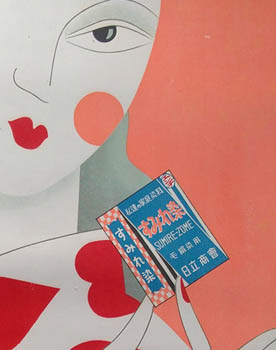


Poster - dye. 私達の家庭染料 - すみれ染 [Watashitachi no Katei Senryo : Sumire Zome]. [Tokyo? 193-?]. Colour poster 52x36cm. In excellent shape. Au$150
Sumire dye was the home dye of choice for modern vamps.






Lindley Murray. 英語階梯 [Eigo Kaitei] An English Spelling-Book, with reading lessons, for beginners at the school Kaiseidzio in Yedo. First edition. Yedo. The 2. year of Kei-ou. (Tokyo, 1866). 18x12cm publisher's wrapper, without title label. Thoroughly annotated by a bored student on the covers, inside and out, the first blank and half title, at the very end and the back blank; clean from the title page on. What a canny colleague called evocative and still rather good. Au$500
The first English spelling book published in Japan according to Ishihara Chisato who announced in 1980 (『英 語 階 梯 』と Lindley Murray のス ペ リ ン グ ブ ッ ク に つ い て [Eigo Kaitei and Lindley Murray's Spelling Book] ) that it is a slightly modified version of Part I of Murray's 'An English Spelling Book' from a copy of the 45th edition (Baudry, Paris 1839) then owned by the Tokugawa government school.
With all of these handy lessons for beginners in a new language I wonder how any Japanese learnt enough English to hold a sensible conversation about anything.
Worldcat only found, for me, Kyoto U's 1867 reprint without the name of the school.
Note that the book opens right to left.




MURRAY, Lindley. 英吉利小文典 [Igirisu Shobunten] Abridgment of Murray's English Grammar. n.p. n.d [186-?]. 18x12cm publisher's wrapper with title label (rubbed). Quite good. Au$300
This is the first part and I know a second part exists because Waseda has a copy - but not this first part. Worldcat finds neither and a hunt through Japanese libraries doesn't help much. No-one seems clear on when this appeared but it is likely to be with the beginning of government schools and is a good partner for the version of Murray's spelling book published by the Kaiseidzio school in 1866.
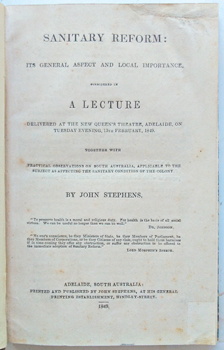


STEPHENS, John. Sanitary Reform: its general aspect and local importance, considered in a lecture ... Adelaide, printed & published by Stephens 1849. Octavo modern quarter crushed morocco by Bayntun-Riviere; viii,64pp and a number of blanks for bulk. Small repairs to the corners of the title page. Au$500
It seems that subscribers to the South Australian Register and the Adelaide Observer got copies of Stephen's three hour lecture whether they wanted or not: Stephens was the editor and owner of both. Still, it's quicker to read than hear.
And still, this is solid pioneering sanitary reform with plenty of evidence that the poor die faster, younger and more often than the well to do by magnitudes, and that legislation is urgently needed. Adelaide was, after all, "litterally living on a dunghill of thirteen years' standing." Stephens was a dedicated trouble maker whose presses had been seized the year before, gathered eight libels suits in this year - though he was mostly off sick - and died the next year.
A glance at Worldcat and Trove would convince you that there are plenty of copies of this, until you start weeding out the facsimile printing.
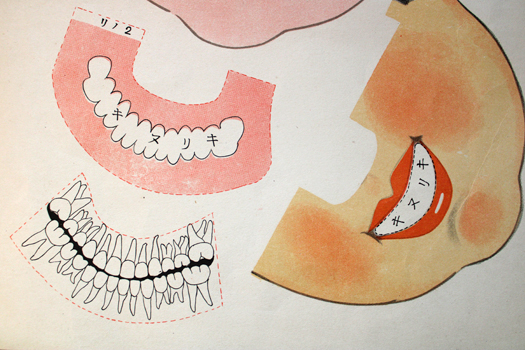
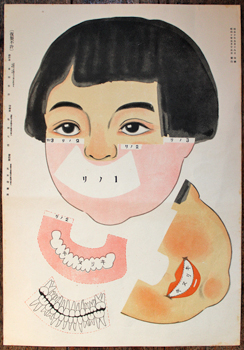
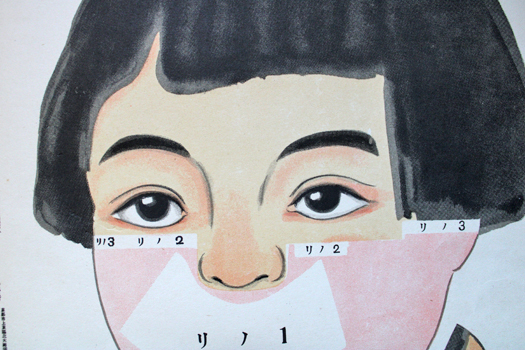

Paper toy - teeth. A cut out and assemble anatomy model. Kyoto 1935. 39x27cm colour print on light card. Au$100
I think I'm happy to report this creepy child is not a fukuwarai - a blindfold game with a face to put together - but apparently someone's idea of educational fun in the dental world. The main heading in the left column declares that is not to be reproduced.



Imaginary Voyage. Voyage de Robertson, aux Terres Australes, traduit sur le manuscrit Anglois. Amsterdam 1766. Duodecimo contemporary calf (tips a bit worn); with half title. Light browning, a rather good copy. sold
First edition of this French - and only French; it is yet to exist in English - imaginary voyage to Australia which apparently was very soon re-issued with signature G mostly removed and replaced - an attack on parliament replaced with an attack on the encyclopedistes - and a new title page dated 1767. This was worked out in the Davidson sale where both issues were offered and comment made on the "marked rarity of this 1766 first issue". It was reprinted in 1767 using the second text.
It is time for booksellers and academics to stop repeating that this is sometimes attributed to Louis-Sebastien Mercier, occasionally offering Barbier as their authority. Barbier is clear, quoting M..... , ex-royal censor, that Mercier was enlisted by Paris bookseller Herissant to hastily hastily write some acceptable filler so's the book could be sold in Paris. Thus replacing a very mediocre section with an even more mediocre section according to either M..... or Barbier, who adds that copies of both must be owned to have the complete text. There was no reason to hide Mercier's authorship of the whole book by then.
So, is this the first suppressed Australian book?




Exhibition - Tokyo 1890. 第三回内国勧業博覧会真景 [Dai Sankai Naikoku Kangyo Hakurankai Shinkei]. Okada Chubei 1890 (Meiji 23). 38x53cm engraving. Folded, rumpled with some smudges and a short tear in one margin. Au$125
The Third National Industrial Exhibition was, as often, a scaled back event: it was planned as an Asian exhibition. I can't find the first electric street car in Japan, unless what looks like an old locomotive with no smoke stack is a lazy artist's stand in. Still, there's no laziness anywhere else here.

Australian Aborigines. Keystone View Company. Stereoscope card: Native Australians Hunting. Keystone [190-?]. Stereo images on printed card (89x178mm); printed description on the back. In fine condition. sold
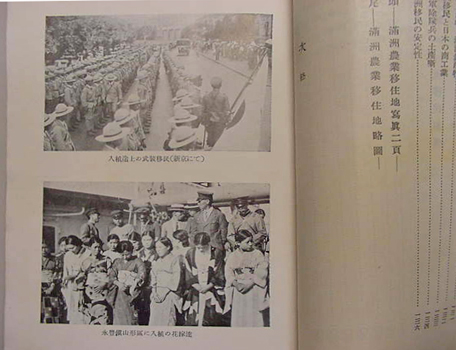
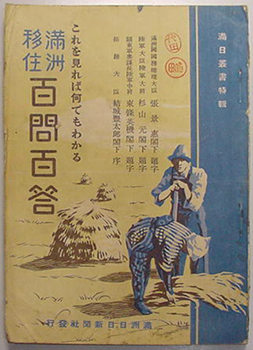
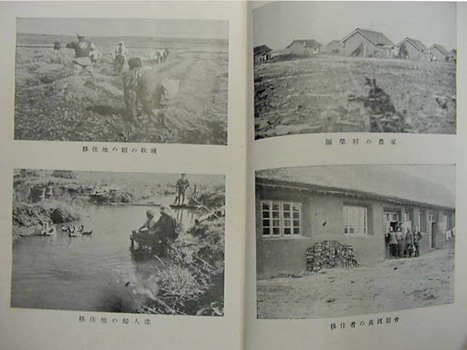
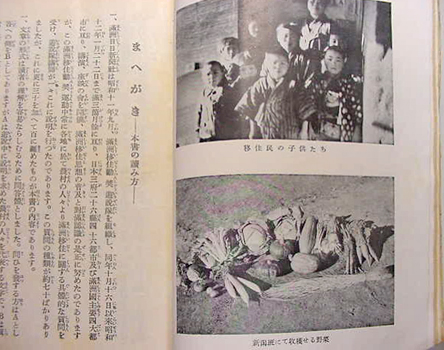

Manchuria colonisation. 満洲移住百問百答 [Manshu Iju Hyakumon Hyakuto]. Manchuria Nichinichi Shimbun 1937. 19x13cm publisher's illustrated wrapper (a bit used); 138pp, some photo illustations and diagrams. Au$275
Everything a poor Japanese farmer needed to know about resettling in Manchuria in 100 questions and 100 answers, published by the Manchuria daily news. This was the Manchuria Million Houses Plan, created in 1936 and put into action in 1937, which was to see a million households of poor farmers resettled in northern Manchuria over the next twenty years. It seems that of the almost quarter of a million settlers abandoned there when the Soviets invaded at the end of the war about half made it back to Japan.
Worldcat finds no copies, neither does NDL, and CiNii finds a scant handful in University libraries.

ANDERSEN, Hans Christian. A Poet's Bazaar. From the Danish ... by Charles Beckwith, Esq. London, Bentley 1846. Three volumes publisher's red cloth decorated in blind (the first volume rebacked with the original pine preserved); frontispiece portrait. Some minor flaws and signs of use (a corner torn from one leaf well away from the text is the worst I can see); a pretty good set from the Andersen collection of biographer and buff Eiler Hoeg with appropriate bookplates. Au$850
First English edition. Travels south and east through Europe to Greece and Constantinople. 1846 was Andersen's breakthrough year in England; three translations of his tales and this appeared. He was deeply unhappy with Mary Howitt, the first into print, but apparently tolerant enough of the rest. Howitt translated from German which is probably why this specifies that Beckwith (Beckwith Lohmeyer in full, an English resident of Copengagen who taught Andersen English) worked from the original.





Catalogue - Building. Saxton & Binns Ltd. Sydney. Saxton & Binns Ltd. Timber Joinery and Builder's Supply Merchants. Pyrmont Sydney. Sydney, November 1910. oblong folio, 28x44cm, colour illustrated wrapps (a lithograph birds-eye view of their works on the front, a photo of their wharf on the back); 40pp, illustrated throughout. Certainly used, with dog ears, creases and short tears in the margins, but a complete and servicable copy; better than the other one I had about a hundred years ago. Loosely inserted is some correspondence - a quote, specifications and a floor plan for a small cottage - from an H. Thwaites, apparently a builder near Wyong, NSW; a list and calculations of materials for the cottage; and a letter to Thwaites about the sale of land and a possible client. All date from around 1923. sold
Rare and rather splendid. Pyrmont and Glebe timber merchants had a spell of competition over the scale of their catalogues at about this time so of course few survived in one piece. With quantities of moulding profiles presumably at full scale, likewise rails, skirtings, architraves, &c; bargeboards & facias, staircases, gates, doors & windows, church furniture, shop fronts & counters, mantels, and a series of weatherboard cottages in the vaguely gothic style which will be instantly recognised by the inhabitants of many suburbs and towns, a weatherboard church and, at the end, three 'export cottages for hot climates'.

WALLER, James. Dedicated to The Volunteer Forces of Australia. Australia! A Patriotic Song .... Sydney, W.J. Johnson & Co. [1863?]. 34x25cm disbound and loose; [2],6pp (last blank). Used, first and last leaves a bit ragged along the front edge but not too bad; much better than the NL copy reproduced online. Signed by Waller and further inscribed (to Miss Midge?) with the composer's loving regards. sold
Waller, a busy man, was also a busy and mostly popular amateur bass despite the critic of The Australian in the mid fifties telling the country that he, Waller, would or could not hear himself and learn to sing with a chest voice, rendering many musical evenings miserable.
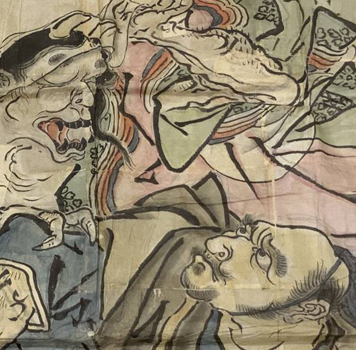
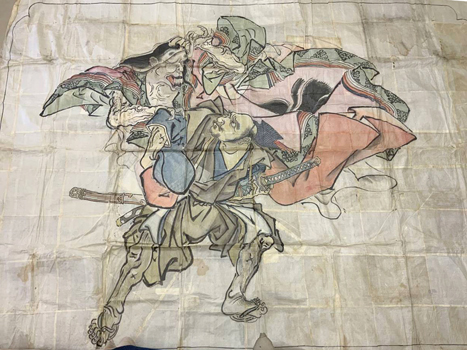
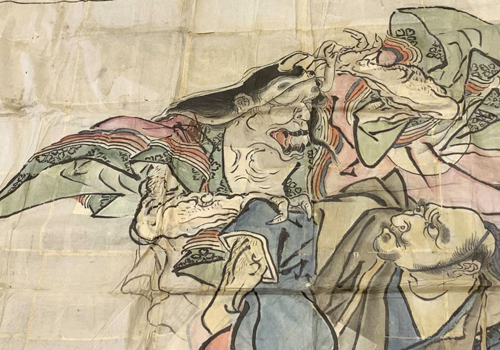
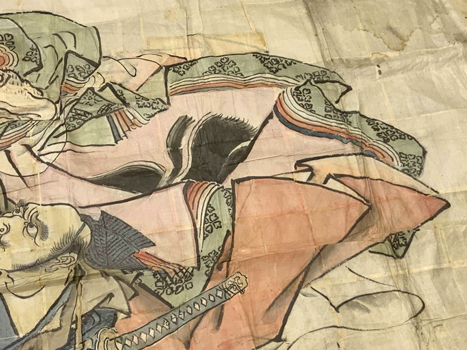
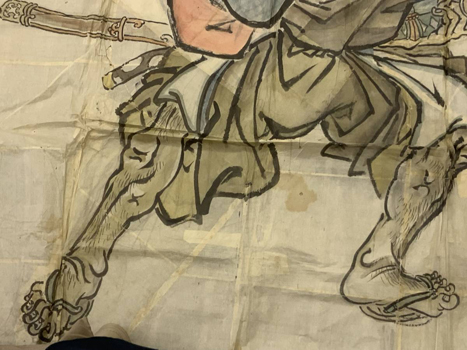

Funpon. Watanabe no Tsuna and Ibaraki doji. A gigantic lifesize funpon or preparatory drawing of Watanabe no Tsuna and the demon, Ibaraki doji, probably for a painting or plaque in a temple or shrine. n.p. mid c19th? 230x340cm, drawing in ink and colours on multiple joined sheets of paper. Au$750
A dynamic snapshot of the moment that Ibaraki has transformed from a beautiful woman and is attacking the indomitable Watanabe and just before she (or maybe he) makes the mistake of grabbing his scant hair. Seconds after this she will lose an arm. The lesson for us all is that if you want to eat a balding man don't mess with the hair.
Our drawing might owe a lot to a print by Katsukawa Shunzan (a) which in turn owes a lot to one by Katsukawa Shunsho (b) and leads to another by Katsukawa Shuntei (c), not of Watanabe and Ibaraki but of Tomoe Gozen subduing a warrior, with an intriguing family resemblance.
Cleveland Art Museum has a large funpon - what we used to call a cartoon - of Ibaraki-doji, by Shibata Zeshin c1840, they say is a preparatory drawing for a wooden plaque to be offered to a shrine and that may well also be the explanation for this. It was a singular part of a bundle of what seemed to be full size drawings for carved decorations for shrines or temples. The bundle was separated before I saw it.
In case any of this makes me seem erudite I must confess that it's owing to Ms Counsell of Hozuki Books in Tokyo. She confirmed my wild guess about the subject and pointed me toward the Katsukawa prints. As for this drawing; probable debt to the Katsukawa school aside, this is a good drawing, sure and alive. Who drew it? Mbrno.

CLAPPERTON, Robert Henderson & William HENDERSON. Modern Paper-Making. London, Benn 1929. Large octavo publisher's cloth; 365pp & illustrated adverts, numerous photo illustrations, diagrams, measured drawings &c (one folding). A signed presentation from Henderson to G.D. Clapperton. Au$100
First edition, a couple more followed. A solid technical account of materials, treatment and machinery written to encompass the 'amazing advances in the technique of paper-making during the last decade'. It remained the standard work for the next three decades.
The paper making Clapperton and Henderson dynasties remain unplumbed by me. A Clapperton and a Henderson, both sons of neighbouring papermakers, worked for Cowans in Edinburgh and died in the first world war. Is G.D. the earlier generation's George whose 'Practical Paper-Making' was published in its last edition revised by R.H. this same year? And I doubt that it is any coincidence that Clapperton's second name is Henderson.
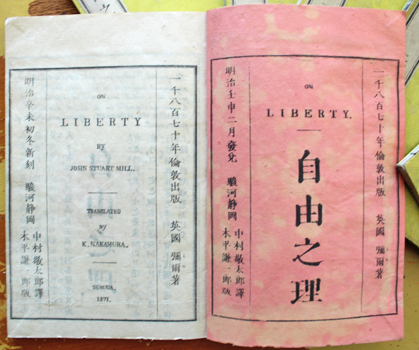
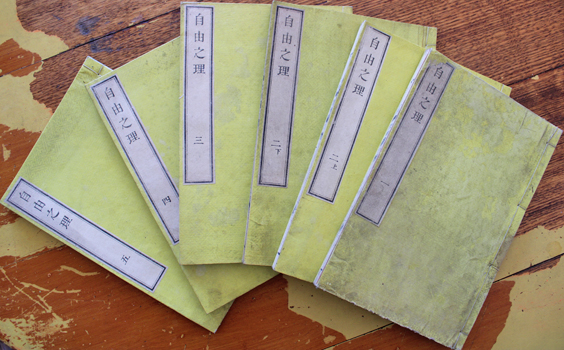

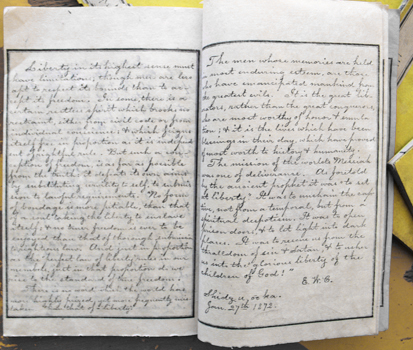

Mill, John Stuart and Nakamura Masanao. 自由之理 [Jiyu no Ri or Jiyuno Kotowari depending on the transcriber]. On Liberty. Shizuoka, Kihira Ken'ichiro [1872]. Five volumes in six books 23x16cm, publisher's yellow wrappers with title labels. Preface in English signed EWC, this was Edward Warren Clark who taught science in Shizuoka and, later, Tokyo. Cover of the first volume dusty; a very good set. Au$2000
The first Japanese edition of Mill's On Liberty - a book that Douglas Howland (in Personal Liberty and Public Good) tells us was "reportedly read by the entire generation of educated Japanese who came of age during the restoration".
I hoped to be able to nail down any issue points and clear up any confusion between the two forms this book takes: the five volumes bound as six books, as here, with volume two divided into two; or bound as five books. The confusion is heightened because many libraries and cataloguers use the 1871 date on the title, ignoring the preface dated January 1872.
I thought that a sort of colophon for Dojinsha - Nakamura's school - pasted inside the last back cover might help, but that leaf appears in both versions. Only the cover labels seem to be different. I've found nothing in any language that examines the printing history and while the rule of thumb - everywhere in the world - is that the more costly version - in materials and time - usually came first, I've had to conclude that there isn't any discernible priority and the difference may well be where, rather than when, the books were bound.
Nakamura's translation of Smile's 'Self Help' was also published by Kihira in Shizuoka and it seems that Kihira Ken'ichiro existed as a publisher only for Nakamura's translations of these two books which he made in Shizuoka - home of the deposed Tokugawa shogun - where he taught after his return from England in 1868 until 1872. In other words, Nakamura was really the publisher of both books.
Worldcat finds five, maybe six, locations outside of Japan - one in Britain, the rest in the US - all but one are catalogued as 1871.

CROMIE, Robert. The Next Crusade. London, Hutchinson 1896. Octavo publisher's illustrated cloth blocked in red, yellow, blue, black, silver and gilt. Edges spotted but a rather good bright copy. Au$250
First edition. A scarce sci-fi thriller describing the "coming struggle" between England and Russia by the writer who didn't live long enough to twice accuse H.G. Wells of plagiarism. He accused Wells of snaffling his space ship for 'First Men on the Moon' but died before Wells' use of an atom bomb in 1914.

WELSH, Charles. Chauffeur Chaff or Automobilia. Boston, Caldwell 1905. Smallish octavo publisher's cloth with mounted colour illustration (with added embossing) on the front. Pretty good. sold
An uncommonly good copy of a book that is not so common anyway. A 'lighter side' of this still new fangled motoring business; the perfect gift for the motorist.

JEROME, Jerome K, Three Men on Wheels. NY, Dodd Mead 1900. Octavo publisher's illustrated green cloth blocked in black and ochre; plates and illustrations through the text by Harrison Fisher. A nice copy. Au$50
First American edition of 'Three Men on the Bummel' and published the same year. Despite the American habit of dumbing down anything that might possibly be misconstrued or considered too mysterious to investigate further, this edition is a prettier book than the English. And bummel is still explained at the end.



New York. Humphrey Phelps. The Great Metropolis. Phelp's New York City Guide ... NY, Gaylord Watson 1874. Small octavo publisher's printed orange boards (some scuffing); 72pp and large folding handcoloured map (405x720mm), wood engraved frontispiece and illustrations throughout. The guide book is a bit used but there are only a couple of small holes in the folds of the map, a surprisingly good crisp copy. Au$375
"From this great centre radiates - by telegraph, steamers, and railroads - new fashions and follies, daily ... and what is said or done is sought after with eagerness by the thirty millions of freemen," says the introductory note. Whatever else has changed in the city, smug self regard hasn't budged in a hundred and fifty years.






Itagaki Takao. 藝術界の基調と時潮 [Geijutsukai no Kicho to Jicho]. Tokyo, Rokubunkan 1932 (Showa 7). 22x16cm, publisher's cloth with onlaid colour illustration, mildly used printed card slipcase; 428pp including 36 pages of photo illustrations. Rather good. Au$650
First edition. Itagaki was seemingly indefatigable as a champion of modernity and modernism in the late twenties and early thirties. Between 1929 and 1933 he worried at the relationship of the machine to art, design, architecture, photography and film, propounding his concept of "machine realism" in a small bundle of books like this. Come the deadly government crackdown on Itagaki's natural disputants - the "proletarian realists" - he apparently retreated into conservative didactic writing on western art and film.




Kon Wajiro. 新版大東京案内 [Shinpan Dai Tokyo Annai]. Tokyo, Chuo Koronsha 1929 (Showa 4). Octavo publisher's illustrated boards and slipcase; 380pp and four double page maps, illustrations throughout, several full page. Inner front hinge cracked, a rather good copy of a smart but badly put together book. Au$300
First edition of a new guide to a new Tokyo by the founder of Modernology. This is not a guide to carry round, the flimsy construction puts paid to that if you try. Tokyo is divided into culture, purpose and theme more than districts. It comes out of the years spent documenting Tokyo and its people after the 1923 earthquake - what is now called urban ethnology - and work done with other designers and architects shaping the new Tokyo. It is sort of an adjunct and a preface to the Modernologio books to come in the next couple of years.





Nakajima Shunko. 古今秘伝築山庭造法 [Kokon Hiden Tsukiyama Teizoho]. Osaka, Aoki Suzando 1896 (Meiji 29). Three volumes, 18x12cm, publisher's wrappers with title labels. Profusely illustrated throughout. The third volume, which is all double page and folding plates, has a pasted paper spine rather than stitching and is coming loose. An outstanding set in colour illustrated outer wrapper (fukuro). Au$200
The secrets (hiden means secret) of Tsukiyama garden design, which I have now learned is something I always wanted: gardens with artificial hills, streams and ponds.




Exhibition - Melbourne 1866-67. Intercolonial Exhibition of Australasia, Melbourne 1866-67. Official Record, containing, introduction, catalogues, reports and awards ... essays and statistics. [and] The Australasian colonies at the International Exhibition, London, 1862. [and] A Treatise on Australian building stones. Melbourne, Blundell 1867 [1865 & 1864]. Stout octavo publisher's cloth; xliv,9-404,iv,563,102,46pp; folding ground plan, five geological maps and plates (four folding). Minor signs of use, quite good.
Presentation copy to Nathaniel Levi - pioneer Jewish politician and businessman, including a stint as a distiller; with a printed slip on the front endpaper and his signature on the back. Loosely inserted is a carte-de-visite portrait by Andrew Rider - an award winner at the exhibition. This may or may not have anything to do with Levi. Au$1500
As well as the local colonies, New Zealand, New Caledonia and Batavia contributed. As with the 1854 and 1861 exhibitions in Melbourne this was a lead up to sending things on to Europe, in this case the 1867 Paris Universal Exhibition, with the consequence that late visitors to Melbourne were met with some large gaps and sparse remnants in many cases.
The extensive series of essays include Brough Smyth on mining, Bleasdale on gems and precious stones, Mueller on vegetation, M'Coy on zoology and palaeontology, Ellery on climate, and much more.
The last two works, both by J.G Knight, on the 1862 exhibition and building stones were not added to standard copies, not even to all presentation copies.




Exhibition - Melbourne 1880. Report of the Executive Commissioner on the Melbourne International Exhibition 1880-81. Sydney, Govt Printer 1881. Largish octavo publisher's morocco; six autotype photo plates and two folding plans. Some foxing, mostly at each end. A handsome copy. Au$650
An uncommon record from Melbourne's natural enemy but the NSW Commissioner is gracious, given that Sydney had held the first international exhibition the year before. Only in passing does he remark that it's a pity Melbourne is so flat they couldn't find an elevated spot to park their building. He doesn't mention that Melbourne is a follow up to Sydney more than three or four times a page.
Included is the catalogue of New South Wales' exhibits and list of jury award winners.





Murakami Yasokichi. 入墨の履歴 [Irezumi no rireki]. [Privately printed 1929]. 19x13cm publisher's printed wrapper; 12pp and three photo plates and tipped in colour woodcut. Mounted on the front cover is a slip with the characters for 'Murakami' and his seal. Inside a colour woodcut senjafuda likewise with his name and seal. Front cover sometime used as a table mat with a couple of cup rings and splodges, all ok once we're past that. sold
A rare tattoo autobiography, the title more or less translates as Why I Got My Tattoo. There are no common old books on tattooing but I doubt there are many scarcer than this. Murakami Yasokichi (1857 - 1933) who by the time he wrote this had become president of the Edo Choyukai - the tattooist association - was first tattooed in Taiwan in a ploy to save his life when he had been taken prisoner. The serious tattooing began as a way of hiding that Taiwan marking. The colour woodcut here is Murakami following orders during the Sino-Japanese war of 1894. If you want to know what happened to Murakami afterwards you can find photos of his skin pinned onto a wall in the Tokyo University.
I can't find a record of this in any library, in or out of Japan.





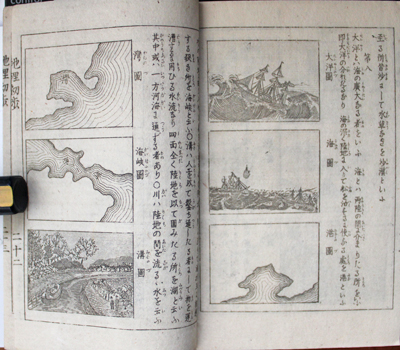

Hashizume, Kan'ichi (publisher). 銅版 小学入門 地理初歩 [Doban : Shogaku Nyumon : Chirishoho]. Tokyo, Hashizume 1875 (Meiji 8). 11x8cm publisher's wrapper with title label; 22 double leaves (44pp), illustrations thoughout. An outstanding copy in the original printed outer wrapper (fukuro). Au$300
Another charming little version of this introduction to elementary school studies, this time engraved (Doban in the title means engraved) and devoted to geography. I've traced another Hashizume Shogaku title but not this one.






Vietnam: anti war and underground American press in Japan. A collection of newspapers and leaflets produced by or for the American military in Japan during the Vietnam war. vp (Okinawa, Iwakuni, Yokosuka, Tokyo &c) vd c1969-74, mostly 1970 to 1972. 71 items in two old folders (plus a few duplicates) of various sizes on various papers ranging from the clumsiest mimeograph leaf to reasonably well printed offset - most down the lower end of the production scale - many illustrated with varied success by photo or drawing. The condition ranges from shabby but complete to fresh off the press - mostly up the top end of the condition scale. Au$3500
A splendid collection made by someone who must have been involved in the production of some of these ephemeral outcries. I suspect a member of the Beheiren - the loose organisation of Japanese opponents to the Vietnam war: on one Beheiren piece the address and phone numbers have been updated by hand; with another, three fresh copies on different colour paper have been preserved. There are annotations here and there in English and a few in Japanese.
There may be a more complete collection of these things somewhere in the world but I haven't found it. I thought the Wisconsin Historical Society GI Press collection was such a place until I discovered that it is a digital collection scanned from pieces all over the world by the dedicated academic James Lewes. He didn't find quite a few things that are here.
Titles include Semper Fi; We Got the brASS; Yokosuka David; GI Free Press Okinawa; Fall In at Ease; Demand for Freedom; GI Newsletter; the 1st Amendment; Omega Press; Freedom of the Press.
Most of these say adamantly that the authorities were not allowed to confiscate them; I wonder how that worked in practice.





Facsist Anti-Communism. Le Communisme c'est la Vie Triste, Morne, Grise. n.p. [France 194-?]. Octavo publisher's illustrated wrapper; 8pp including wrapper. Illustrated throughout. Au$175
A fine graphic warning about the perils of believing the patriotic bilge of French communists during the occupation.